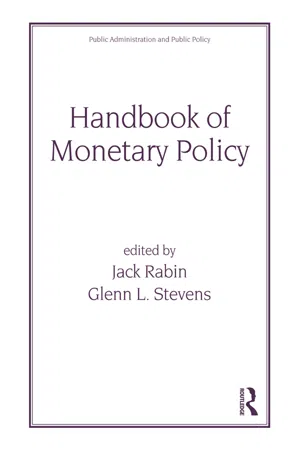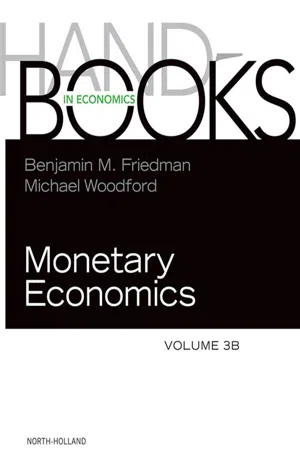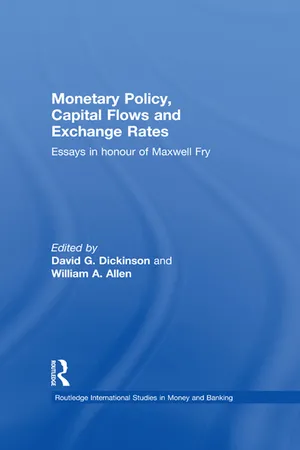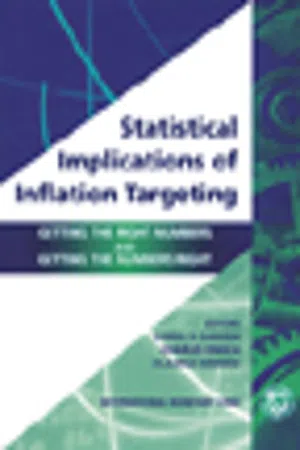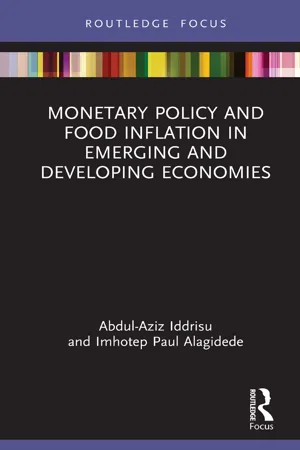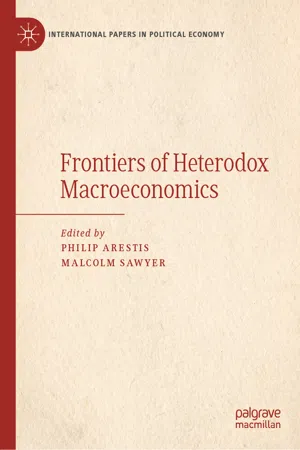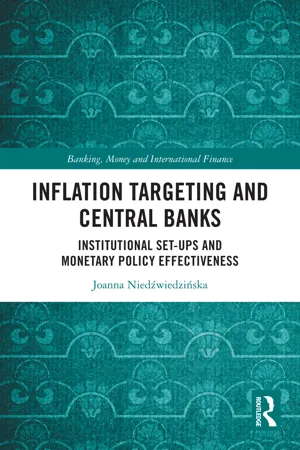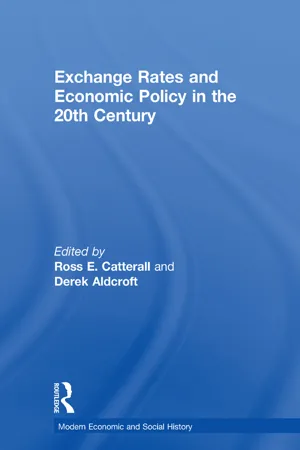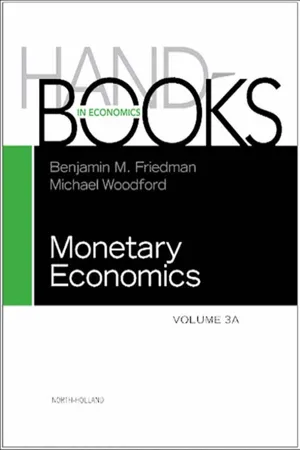Economics
Inflation Targeting
Inflation targeting is a monetary policy framework where a central bank sets an explicit target for the inflation rate and uses its policy tools to achieve that target. The goal is to maintain price stability and anchor inflation expectations. Central banks communicate their targets and policy actions to provide transparency and guidance to the public and financial markets.
Written by Perlego with AI-assistance
Related key terms
11 Key excerpts on "Inflation Targeting"
- eBook - ePub
- Jack Rabin(Author)
- 2020(Publication Date)
- Routledge(Publisher)
Conducting Monetary Policy with Inflation TargetsGeorge A. KahnVice President and Economist, Federal Reserve Bank of Kansas City, Kansas City, MissouriKlara ParrishAssistant Economist, Federal Reserve Bank of Kansas City, Kansas City, MissouriReprinted from: Federal Reserve Bank of Kansas City Economic Review, v. 83, n. 3 (Third Quarter 1998) 5–32.Since the early 1990s, a number of central banks have adopted numerical inflation targets as a guide for monetary policy. The targets are intended to help central banks achieve and maintain price stability by specifying an explicit goal for monetary policy based on a given time path for a particular measure of inflation. In some cases the targets are expressed as a range for inflation over time, while in other cases they are expressed as a path for the inflation rate itself. The measure of inflation that is targeted varies but is typically a broad measure of prices, such as a consumer or retail price index.At a conceptual level, adopting inflation targets may necessitate fundamental changes in the way monetary policy responds to economic conditions. For example, Inflation Targeting requires a highly forward looking monetary policy. Given lags in the effects of monetary policy on inflation, central banks seeking to achieve a target for inflation need to forecast inflation and adjust policy in response to projected deviations of inflation from target. But central banks without an explicit inflation target may also be forward looking and equally focused on a long-run goal of price stability. Thus, at a practical level, adopting inflation targets may only formalize a strategy for policy that was already more or less in place. If so, targets might improve the transparency, accountability, and credibility of monetary policy but have little or no impact on the way policy instruments are adjusted to incoming information about the economy. - eBook - ePub
- Benjamin M. Friedman, Michael Woodford(Authors)
- 2010(Publication Date)
- North Holland(Publisher)
Chapter 22Inflation Targeting
Lars E.O. Svensson Sveriges Riksbank and Stockholm UniversityAbstract
Inflation Targeting is a monetary-policy strategy characterized by an announced numerical inflation target, an implementation of monetary policy that gives a major role to an inflation forecast that has been called forecast targeting, and a high degree of transparency and accountability. It was introduced in New Zealand in 1990, has been very successful in terms of stabilizing both inflation and the real economy, and as of 2010 has been adopted by about 25 industrialized and emerging–market economies. This chapter discusses the history, macroeconomic effects, theory, practice, and future of Inflation Targeting.JEL classification : E52, E58, E42, E43, E47Keywords Flexible Inflation Targeting Forecast Targeting Optimal Monetary Policy TransparencyContents1. Introduction12381.1 An announced numerical inflation target12391.2 Forecast targeting12391.3 A high degree of transparency and accountability12401.4 Outline12412. History and Macroeconomic Effects12422.1 History12432.2 Macroeconomic effects12442.2.11246Inflation2.2.21247Inflation expectations2.2.31248Output2.2.41249Summary of effects of Inflation Targeting3. Theory12503.1 A linear–quadratic model of optimal monetary policy12523.2 The projection model and the feasible set of projections - William Allen, David Dickinson(Authors)
- 2002(Publication Date)
- Routledge(Publisher)
During the quarter-century since then, the rate of inflation has been reduced tenfold, from over 25 per cent to below 2.5 per cent. The fall in the rate of inflation has not been steady or continuous. There have been a number of crises, and a number of different monetary policy techniques have been used. Inflation Targeting is the latest of them, adopted after the United Kingdom left the European Exchange Rate Mechanism, and it has been the longest-lasting. The procedures of Inflation Targeting are still evolving in the light of continuous learning through experience.Inflation Targeting is based on the assumption that low inflation is the single proper objective of monetary policy. That assumption is based, in the United Kingdom, on the unhappy experience of trying to pursue other objectives with monetary policy. It is beyond the scope of this paper to justify the assumption that price stability should be the proper objective of monetary policy. Briault (1995) sets out the arguments: the public debate in the United Kingdom has become much less heated in the last few years, perhaps largely because low inflation has been accompanied during those years by strong economic growth and falling unemployment, so that there has been no sign of a conflict between low inflation, high growth and high employment.Nevertheless, there have been some complaints in the United Kingdom that the fact that the central bank is pursuing an inflation target means that it is not concerned about output and employment. This is a misconception, because the inflation target is symmetrical. It is just as serious a policy error for inflation to be below target as it is for it to be above target, and if inflation is expected to be below target, it is the Bank of England’s duty to ease monetary policy. Moreover, the Bank of England is required by law to support the Government’s economic policy, including its objectives for growth and employment, subject to the overriding objective of maintaining price stability.- eBook - ePub
- Carol Carson, Claudia Dziobek, and Charles Enoch(Authors)
- 2002(Publication Date)
- INTERNATIONAL MONETARY FUND(Publisher)
Inflation Targeting has been adopted by several countries with floating exchange rate systems as a way to anchor inflation expectations. Many other countries are actively considering this possibility, and some are committed to do so under IMF-supported programs. After a decade of experience, we have seen inflation-targeting regimes in action, and we are beginning to have a basis for assessing their performance and refining our views on how best to manage them.Passage contains an image
Implications of Inflation Targeting
As the IMF stresses to countries that are considering the adoption of Inflation Targeting, the keys to success are transparency and credibility. Once a political decision has been taken to make the inflation target the primary objective of monetary policy, it is crucial for the monetary authorities to keep the public regularly informed about the actions they have taken to meet that objective and the basis for the judgments that they make. Perhaps even more than other monetary regimes, Inflation Targeting obliges the central bank to safeguard its credibility in pursuing the inflation goal. For this reason, inflation targeters are almost invariably countries in which the central bank has a high degree of operational independence. But it is also important to avoid a deflationary bias, which would impose unnecessary costs on society and risk undermining the political basis for the inflation-targeting regime and the independence of the central bank.While there are now many analyses of the experience under Inflation Targeting, relatively little has been written about the implications for economic statistics. This is an important omission. In preparing for Inflation Targeting, most countries have adopted an existing, well-known price index as the target—generally the national consumer price index (CPI)—and they have used a selection of available data series in forecasting inflation and assessing the effects of monetary policy. Moving forward, it will be important to explore whether this is the most appropriate index to target, whether some components of the CPI should be systematically excluded from or added to the index, and what new statistics might be needed for related analysis and forecasting. - Abdul-Aziz Iddrisu, Imhotep Paul Alagidede(Authors)
- 2021(Publication Date)
- Routledge(Publisher)
2 Inflation Targeting framework in emerging and developing economies: Experiences and milestonesDOI: 10.4324/9781003195368-2Introduction
The inflationary episodes of the 1970s and parts of 1980s that struck a number of advanced economies prompted a transition to Inflation Targeting framework by these countries as monetary policy strategies such as the monetary targeting and pegged exchange rate regimes could not deliver the needed price stability (Svensson, 2011 ). Masson et al. (1997) reckon that the challenges of monetary targeting and pegged exchange rate regimes in the 1990s precipitated an exodus to Inflation Targeting framework by a number of advanced economies as a way to improve their inflation footprint. New Zealand was the first nation to unveil Inflation Targeting framework in the world in the year 1990. Other advanced countries followed, with Canada unveiling the framework in 1991, the United Kingdom in 1992, Australia in 1993 and Sweden in 1995. What the Inflation Targeting framework embodies and the foundations that define its successful implementation or otherwise are the subject of the succeeding sections of this chapter.The nature and pre-requisites of Inflation Targeting
The Inflation Targeting framework involves public communication of a quantitative inflation target by a central bank, to which it exercises commitment and strives to achieve in order to establish credibility and anchor inflation expectations. The framework also embodies transparency and engender accountability as monetary policy authorities regularly engage the public on decisions arrived at and the factors that informed the said decisions. Such transparency and public engagements help to shape the inflation expectations of the public in a way that engender convergence to the announced inflation target.The numerical or quantitative inflation target can be a range, a point target with or without a tolerance band (Svensson, 2011). For instance, South Africa has an inflation target range of 3%–6%; Ghana has a point target of 8% with a tolerance band of 2% (thus 8% ±- eBook - ePub
- Philip Arestis, Malcolm Sawyer, Philip Arestis, Malcolm Sawyer(Authors)
- 2019(Publication Date)
- Palgrave Macmillan(Publisher)
Furthermore, when the inflation target is not met, the question arises how the central bank is formally held accountable; are explicit sanctions in place for this case? Therefore, the time horizon over which to meet the target is important. Following the theoretical background of Inflation Targeting, the effect of monetary policy on real activities is not only minor, but if existing it is only relevant in the short run. This means the alternative secondary goals are also only relevant in the short run and the implementation of inflation targets is to be seen within the scope of a medium or longer run policy. Some possible aspects of the inflation target scheme are used only rarely. The Law of New Zealand for example includes direct accountability of central bankers, and the tenure of the governor is linked to the achieving of the respective target (Bernanke and Mishkin 1997, p. 100; Debelle 1997, p. 18). No other economies seem to have implemented such a legal accountability. Central banks present their accountability sometimes via publications, like the inflation reports or monetary policy reports (e.g. Debelle et al. 1998, p. 8). 3 Dead Ones Live Longer: Empirical Evidences and Challenges After the Financial Crisis Numerous empirical studies on the effectiveness of Inflation Targeting for developed and emerging markets have been undertaken in recent decades. They vary in empirical method, countries included—with the main question whether to include or exclude so-called implicit Inflation Targeting economies—and time setting—before or after the global financial crisis—but have one striking feature in common: no clear evidence for the positive impact of Inflation Targeting in reducing rate of inflation. As for example Angeriz and Arestis (2006, p. 566) point out, inflation started to decrease in many of targeting economies even before Inflation Targeting as monetary policy was put in place - eBook - ePub
Inflation Targeting and Central Banks
Institutional Set-ups and Monetary Policy Effectiveness
- Joanna Niedźwiedzińska(Author)
- 2021(Publication Date)
- Routledge(Publisher)
81 For example, price-level targeting implies that if inflation is too high, the central bank must tighten monetary policy, even risking a recession to return to the previously announced price-level path, which, in practice, would be highly problematic. In turn, nominal GDP targeting requires that potential output is well specified, otherwise constant revisions of the targeted nominal GDP path would be necessary. Also, other targeting rules may, in fact, result in increasing—instead of decreasing—the instability of the economy. Thus, the implications need to be carefully considered, which will probably take some time. With the US Fed announcing average Inflation Targeting in August 2020, the trial period has started and will be carefully analysed by other central banks.Importantly, even if some of the alternative targeting rules are adopted in the future, many of the investigated institutional features of Inflation Targeting will most likely remain in place. Particularly in the case of the currently discussed more complex rules, aspects related to the accountability and transparency of central banks’ frameworks can become even more critical.However, there are also proposals that constitute more radical solutions to reforming monetary policy frameworks and the current institutional arrangements, including modern monetary theory (Wray, 1998, 2012; Lavoie, 2019) and the abolishment of paper currency (Rogoff, 2017; Stracca, 2018, pp. 92–101). Despite being present in the discussions, at the current juncture they are less likely to find practical applications (Walsh, 2019).1.7.2 Reviews of monetary policy frameworks in central banks
With the ongoing discussions about feasible alternatives to IT, so far, no visible retreat from Inflation Targeting can be seen. This is partly explained by the observation that—due to its flexibility and evolving nature—the regime allows for accommodating many of the identified deficiencies without the need to abandon the framework altogether.Indirectly, the fact that in 2012 the United States decided to officially announce an explicit numerical longer-run goal for inflation, which brought their monetary policy strategy significantly closer to an Inflation Targeting framework, proved the support for this regime as well. Additionally, also Japan moved in the same direction in 2012. Evidently, at that point, an IT regime was assessed as helpful in reviving inflation, since in these two countries—amidst weak price dynamics—the quantitative inflation targets were supposed to raise inflation expectations. - Derek H. Aldcroft, Ross E. Catterall(Authors)
- 2017(Publication Date)
- Routledge(Publisher)
The use of an exchange rate target eliminates the trade-off between controllability and visibility which exists with an inflation target or a money supply target. The exchange rate target is fully controllable (provided that there are sufficient foreign exchange reserves) and highly visible. However, an exchange rate anchor creates other trade-offs, for example in the area of the balance of payments, and there is a loss of independent monetary policy.While inflation targets are at present in vogue with several monetary authorities, not all countries need to have this framework for the successful conduct of monetary policy (exceptions include Germany and the USA). In countries where the credibility of monetary policy is in question, and the reputation of the central bank poor, Inflation Targeting has controlled the growth of inflation. In the long run, however, the single most important element in any anti-inflation strategy is the degree of commitment of the central bank to achieve low inflation. The jury is still out on whether inflation targets can deliver low inflation over longer time periods, and whether central banks are prepared to persevere with this technique.References
Allen, W.A. (1999), Inflation Targeting: The British Experience, London: Bank of England.Bank of England (1971), ‘Monetary Management in the United Kingdom’, Bank of England Quarterly Bulletin, 11.Clarida, R. and M. Gertler (1997), ‘How the Bundesbank Conducts Monetary Policy’, in Christina D. Romer and David H. Romer (eds), Reducing Inflation: Motivation and Strategy, Chicago, IL: University of Chicago Press.Commission of the European Communities (1970), ‘A Plan for the Phased Establishment of an Economic and Monetary Union’, Bulletin of the European Communities (supplement), 3.Commission of the European Communities (1989), Report on Economic and Monetary Union in the European Community, Luxembourg: Office for Official Publications of the European Communities.Crockett, A. (1994), ‘Rules versus Discretion in Monetary Policy’, in J. Onno de Beaufort Wijnholds, Sylvester C.W. Eijffinger and Lex H. Hoogduin (eds), A Framework for Monetary Stability- eBook - ePub
- Benjamin M. Friedman, Michael Woodford(Authors)
- 2010(Publication Date)
- North Holland(Publisher)
F. Zampolli. Optimal monetary policy in a regime-switching economy: The response to abrupt shifts in exchange rate dynamics. Bank of England, 2006. Working Paper* I am grateful for comments by Petra Gerlach-Kristen, Amund Holmsen, Magnus Jonsson, Stefan Laséen, Edward Nelson, Athanasios Orphanides, Ulf Söderström, Anders Vredin, Michael Woodford, and participants in the ECB conference Key Developments in Monetary Economics and in all seminars at the Riksbank L. and Norges Bank. I thank Carl Andreas Claussen for excellent research assistance. The views presented here are my own and not necessarily those of other members of the Riksbank's Lo and Norges Bank executive board or staff.1 The term “inflation nutter” for a central bank that is only concerned about stabilizing inflation was introduced in a paper by Mervyn King at a conference in Gerzensee, Switzerland, in 1995 and later published as King (1997) . The terms “strict” and “flexible” Inflation Targeting were to my knowledge first introduced in a paper of mine presented at a conference at the bank of Portugal in 1996, later published as Svensson (1999b) .2 The policy rate (instrument rate) is the short nominal interest rate that the central bank sets to implement monetary policy.3 The idea that Inflation Targeting implies that the inflation forecast can be seen as an intermediate target was introduced in King (1994) . The term “inflation-forecast targeting” was introduced in Svensson (1997) , and the term “forecast targeting” in Svensson (2005) . See Woodford (2007) - Marc Pilkington(Author)
- 2013(Publication Date)
- Routledge(Publisher)
Inter alia, this list features Australia, Brazil, Canada, Mexico, New Zealand, Norway, Sweden and the United Kingdom. Policy strategies, tools and communication practices are not necessarily identical, as the latter might differ in the details. However, the common denominator of these central banks is that they all share a flexible interpretation of their mandate. In fact, an explicit inflation target over the medium term does not preclude the existence of an output and/or employment objective in the short run. So in the world of Inflation Targeting, there is assuredly a unity of purpose and a diversity of practices. However, there are a few prominent central banks, such as the European Central Bank (ECB) and the Swiss National Bank, that do not label themselves as ITers. Yet, these central banks are not alien to inflation-targeting practices, as they include key features of that framework for monetary policy. The latter include a ‘numerical definition of price stability, a central role for communications about the economic outlook, and a willingness to accommodate short-run economic stabilization objectives so long as these objectives do not jeopardize the primary goal of price stability’ (Bernanke, 2011b). Bean (2007) echoes our discussion on the (non)Shakespearean view of inflation-targeting, by explaining that the Fed and the ECB are not ITers although they behave as such. Bean (ibid.) therefore emphasizes the commonalities between self-proclaimed ITers and non-ITers. The differences between them amount to the rhetoric of communication. Pilkington (2012b) has raised the issue of the discursive nature of economics, in an ode to pluralism acknowledging the components of heterodoxy. In this respect, the words used by economists (or central bankers) are far from neutral. English for specific purposes and applied linguistics are therefore most relevant disciplinary fields, in order to reinterpret the Shakespearean debate on Inflation Targeting.Inflation Targeting and beyond: (re)shaping the NMCThe present book is entitled The Global Financial Crisis and the New Monetary Consensus- eBook - ePub
What Drives Prices in Egypt?
An Analysis in Light of International Experience
- Hanaa Kheir-El-Din(Author)
- 2009(Publication Date)
- The American University in Cairo Press(Publisher)
CHAPTER 4 Monetary Policy in Egypt:A Retrospective and Preparednessfor Inflation TargetingRania Al-Mashat1I nflation targeting (IT) is one of the operational frameworks for monetary policy aimed at attaining price stability. In contrast to alternative strategies, notably money or exchange rate targeting, which seek to achieve low and stable inflation through targeting intermediate variables—for example, the growth rate of money aggregates or the level of the exchange rate of an ‘anchor’ currency—IT involves targeting inflation directly (World Economic Outlook 2005). In a wider context, IT is part of a process in which economic policymaking is becoming more transparent and subject to greater accountability and technical rules, and less susceptible to discretionary actions.IT has become an increasingly popular monetary policy strategy, with around twenty-one countries, eight industrial and thirteen emerging markets, now inflation targeters. Other countries are seeking to develop the necessary ‘infrastructure’ to implement an IT framework, Egypt being one of the forerunners. However, the technical details related to the adoption of IT are not trivial, and there are several country-specific factors that need to be taken into consideration.Since June 2005, the Central Bank of Egypt (CBE) has taken serious steps to develop its monetary policy framework with the intention of adopting IT over the medium term. The exchange rate has been abandoned as the nominal anchor, and price stability has been declared the overriding policy objective. Key institutional and operational steps have been implemented in the transition.Against this background, empirical research on monetary policy in Egypt has recently come to the forefront as researchers try to investigate the inflation process and reconcile the requirements of IT with economic realities.This chapter attempts to accomplish two tasks. First, it provides a retrospective overview of monetary policy instruments used in Egypt between 1996 and 2005 in an effort to explain the decision-making process. To address this, a parsimonious empirical estimation is conducted to investigate the relationship between monetary aggregates and inflation. Second, the chapter discusses the preparedness of the CBE to adopt an IT framework, in light of the new monetary policy framework launched in 2005 and in comparison to other emerging country cases.
Index pages curate the most relevant extracts from our library of academic textbooks. They’ve been created using an in-house natural language model (NLM), each adding context and meaning to key research topics.
